Al-Subiyah (Kuwait)
Third season of work in Al-Subiyah, Kuwait
Dates: 26 October – 4 December 2009
Team:
Prof. Piotr Bieliński, director, archaeologist (PCMA)
Dr. Łukasz Rutkowski, field director (PCMA)
Dr. Franciszek Pawlicki, archaeologist (PCMA)
Dr. Anna Smogorzewska, archaeologist, ceramologist (Institute of Archaeology, University of Warsaw)
Dr. Magdalena Żurek, archaeologist (Institute of History, Podlaska Academy)
Dorota Bielińska, archaeologist, documentalist (Polish Academy of Sciences)
Anna Maria Kotarba-Morley, archaeologist (freelance)
Roman Łopaciuk, topographer (Geomatic Company)
Maciej Makowski, archaeologist (Polish Academy of Sciences)
Marta Momot, archaeologist, documentalist (PCMA)
Agnieszka Pieńkowska, archaeologist (PCMA)
Andrzej Reiche, archaeologist, photographer (National Museum of Warsaw)
Agnieszka Szymczak, archaeologist (PCMA)
Urszula Wicenciak, archaeologist (University of Warsaw PhD candidate in archaeology)
Łukasz Wojnarowicz, archaeologist (freelance)
Kuwaiti Team:
Sultan Ad-Duweish, head of the team
Mohammad Al-Azmi, Mustafa Al-Ansari, Haled Issa El-Rifai, Talal Abdalla Shameri, archaeologists
For the third time, at the invitation of the Kuwaiti National Council for Culture, Art and Letters, archaeologists from the Polish Centre of Mediterranean Archaeology of the University of Warsaw excavated sites in the As-Sabbiya region. Four separate projects were undertaken concurrently, two of these being a continuation of previous work. The fieldwork will be continued under a newly signed five-year agreement for cooperation between the Kuwaiti National Council for Culture, Art and Letters and the PCMA.
Settlement from the Ubaid Period: SBH 38
SBH (short for Sabbiya-Bahra) 38 is a settlement site in the Bahra region discovered by Kuwaiti archaeologists a few years ago and dated by the pottery to the Ubaid 3 period (that is, c. 4800–4500 BC). The Ubaid layers are buried under no more than 0.20-0.40 m of sand and most of the structures excavated so far are set upon bedrock. It is likely, therefore, that occupation was limited to a single period.
Clearing of stone wall remains seen on the ground surface established the general extent of the site as being at least 120 m E-W by 35 m N-S. Approximately 250 square meters were excavated in the eastern part of the site (Fig. 1), where a large house was discovered.
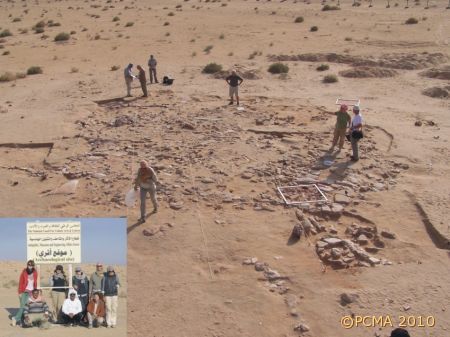
The house (House 1) measures approx. 11.50 by 8.00 m and consists of at least 13, mostly rectangular rooms arranged in three rows (Fig. 2). Their sizes range from 0.60 by 1.90 m to almost 3.50 by 3.50 m. In the middle of one of the largest of these units (locus 8), a domestic installation in the form of a round hearth (diam. approx. 0.70 m) was found. A concentration of shells was found in its vicinity. Two superimposed layers of stone pavement discovered in this particular locus testified to at least two phases of usage. This phasing is also supported by the stratigraphy of two other loci, which also bear traces of refurbishment. At least four rooms in House 1 were paved, either with cobbles or with flat, tightly fitted flagstones (Fig. 3). Their walls, which have been preserved to a height of approx. 0.60 m, were also made of stone, at least in their lower courses.
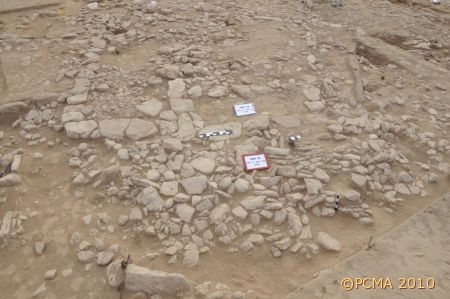
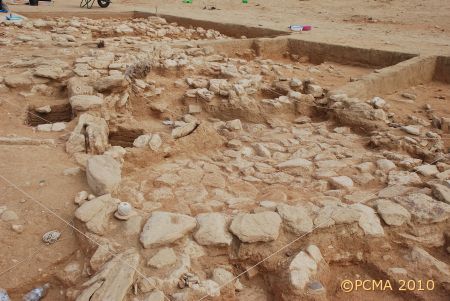
A large quantity of painted and plain Ubaid period potsherds has been recovered from the site. The style and fabric of the vessels make it clear that most of them must have been imported from Mesopotamia. Some coarse red sherds probably represent a local ware. A hard gray residue on practically all the sherds can be removed only with special treatment, substantially slowing down the processing of the ceramic material. At least three complete or almost complete Ubaidian vessels have been recorded in one of the loci (locus 16). Their condition is such, however, that they cannot be lifted without the assistance of professional restorers.
The chipped stone industry is poorly attested despite sieving. So far, only one stemmed arrowhead and fragments of another one have been found. There are also some flake fragments and suspected blade parts, as well as flint fragments of various sizes. Ground-stone tools, mostly hammers, are somewhat more numerous. The most abundant category of finds consists of mollusk shells, animal bones being much less frequent and very poorly preserved.
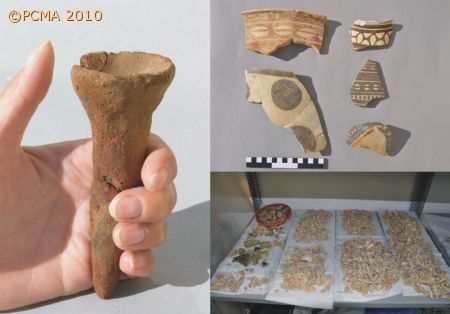
SBH 38 is the second Ubaid period settlement excavated in Kuwait after site H3 which is just about 7 km away. House 1 is reminiscent of Mesopotamian house plans known from Ubaidian sites, such as Tell Madhour and Tell Abada. The use of stone rather than mud brick as the building material may be responsible for some departures from the Mesopotamian model. Moreover, the imported pottery points to a direct connection between SBH 38 and Mesopotamia. A provisional conclusion then is that the site may have been occupied by settlers coming directly from Mesopotamia.
Desert Well Complex: SM 12
The desert well complex (site SM 12) in the Muheita region started to be explored last season and is now practically fully excavated (Fig. 5). It consists of a stone enclosure wall, approx. 0.40 m wide, encircling an oval area, 8.80 by 7.75 m across. In the middle there is a large well with a shaft some 3.30 m deep, measuring approx. 3.20 m at the top and narrowing to about 1.20 m near the bottom. The well appears to have had two major phases of use and it seems reasonable to attribute it to the Islamic period despite a dearth of pottery (a single sherd found last year is still under study). Plans are underway for the conservation and reconstruction of this impressive piece of engineering which is in exceedingly good state of repair.
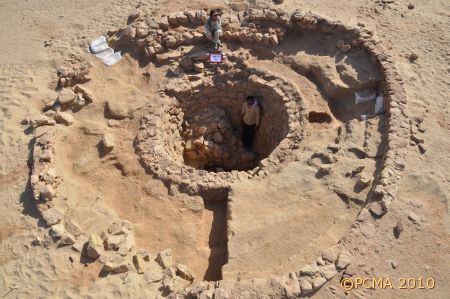
Stone tumuli: SMQ 35a, SMQ 48, SMQ 49 and SM 18
For the past two seasons the archaeological work had focused on burial mounds in the Mugheira area. Four such tumuli were excavated this year. Of these SMQ 49 proved to be the most interesting, both for its size and technical solutions, as well as the contents of its grave chamber (Fig. 6).
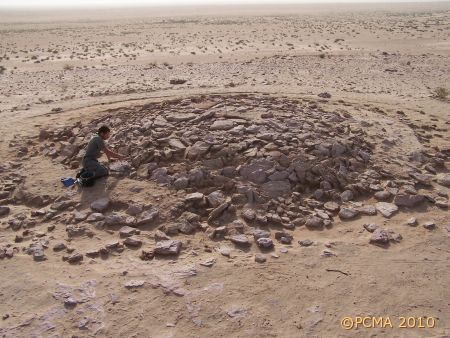
The stone mound measures nearly 8 m in diameter and is approx. 0.80 m high. A coat of carefully laid stones covers rings of large slabs forming the inner structure of the tumulus. The rings encircle an ellipsoidal grave chamber measuring 1.30 m by 0.90 m. At some point the chamber had been broken into by robbers, but despite this the skeletal remains of at least four people were discovered. None of the tumuli investigated so far had had such a number of burials. The bones were not in anatomical position, owing no doubt to grave plundering, but equally so to the practice of pushing aside earlier burials to make room for a new one. Beneath the lowermost human skeleton lay the partly broken and mixed bones of a large animal. The archaeozoologist’s opinion is still pending, but it may have been an equid.
Six perforated shells found within the chamber may have been part of a jewelry set. Four stone tools – two small mortars and two grinders – which were found at the edge of the stone coating of the tumulus, may have also been part of the grave equipment discarded by the robbers. Exploration of the grave chamber has yet to be completed.
A poorly preserved grave, SMQ 48, was also excavated. This grave lies at the foot of a cliff upon which SMQ 49 is situated. SMQ 48 proved to be of much inferior construction compared to the previously described grave and its burial chamber was found empty.
Tumulus SMQ35a was sectioned this year in order to complete the documentation of a grave already explored in the previous season.
The fourth of the excavated tumuli, SM 18, is situated in the western part of the As-Sabbiya—Muheita region. Its construction differs from that of the other SMQ structures in that it had no internal stone ring. A round grave chamber seems to have been built first, followed by the arrangement of stone slabs around it as superstructure. The bottom of the chamber does not rest on bedrock (as is the case with most of the other excavated tumuli), but is excavated in the rock to a depth of approx. 0.40 m. Inside the chamber, a few poorly preserved bones and some teeth were found. The chamber was clearly broken into in the past.
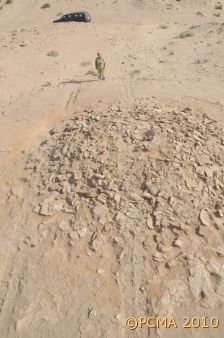
The tumulus also bore signs of more recent damages. The stones of its coating were by far more crushed and fragmented than in any other grave investigated this season. Careful surface cleaning revealed the probable reason: a set of clear caterpillar tracks matching in shape and size an M1 Abrams tank according to a military expert (Fig. 7).
A dearth of small finds (looted, undoubtedly, by ancient grave robbers) leaves the provisional dating of the tumuli open. The suggested chronology ranges from the Ubaid period to the 3rd millennium BC.
Survey: Bahra and Radha regions
A survey of archaeological remains in the Bahra and Radha regions of As-Sabbiya identified sites which were recorded and mapped under the codenames PSBH (for Polish Survey BaHra) and PSRD (for Polish Survey RaDha). The results included unrecorded sites (Fig. 8) as well as ones known to Kuwaiti archaeologists (especially Sultan ad-Duwaish), who excavated some of them. The total of 81 recorded sites was made up of 60 tumuli, four elongated stone structures and 17 other different features. A concentration of tumuli was chosen for future exploration by the Kuwaiti—Polish team.
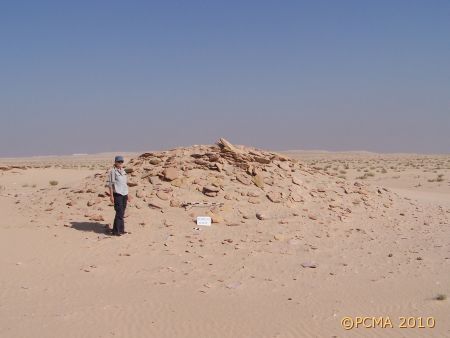

[Text: Agnieszka Szymczak]
